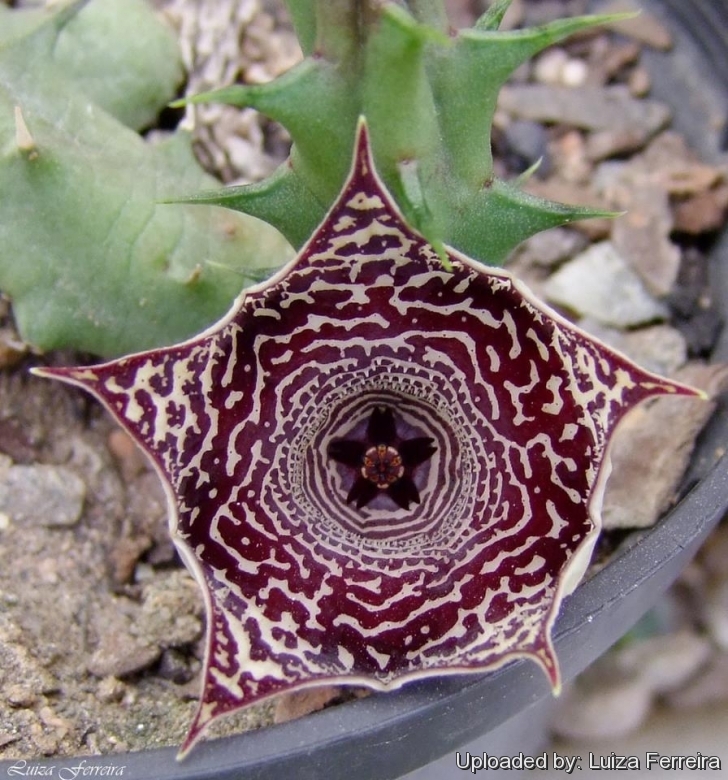
Huernia loeseneriana Photo by: Luiza Ferreira
Origin and Habitat: South Africa (Gauteng on the Magaliesberg and other hills, as well to the east in Mpumalanga and also in the Free State)
Altitude: 1400-1700 metres above sea level.
Habitat: Huernia loesenerianaSN|26308]]SN|26308]] and Stapelia leendertziaeSN|11710]]SN|11710]] occur on summits of hills and ridges north of the Vaal River. While the former seems to prefer open situations and is often rooted in rock crevices, the latter grows commonly on humus soil and partial shade.
Synonyms:
Description: Huernia loesenerianaSN|21240]]SN|26308]] is an easily flowered species that has beige to light yellow flowers with delicate maroon markings reminiscent of leopard spots on the five pointed petal lobes. It has variations because of widespread occurrence in RSA.
Habit: It is a perennial-succulent. The plant branches much at the base to form low clumps or compact mats.
Stems: 3-8 cm long 1-1,2 cm erect or ascending, thick squat, between cylindrical and square, green, purple-tinted at the tips, with soft and short conical whitish spine-tipped tubercles 2-3 mm tall stiffly arranged in 4 acute ribs.
Inflorescences:2-3-flowered near the base of the young stems; Pedicel 4-5 or more mm long; Sepals 4-6 mm long, subulate from an ovate base.
Flowers: Inclined, campanulate, 2-2,6cm in diameter without the prominent ring around the corona found on some of the other Huernia species like Huernia guttataSN|22523]]SN|22523]] or Huernia zebrinaSN|26308]]SN|21240]]. Corolla verrucose, dull yellow with broken fines of brownish red lines, covered inside from the middle of the tube nearly to the tips of the lobes with short stiff compressed-conical obtuse processes, dull yellow, covered with very crowded narrow broken transverse lines and spots of dull brownish-crimson, and entirely of that colour at the base of the tube, but darker. Tube widening upwards and gradually passing into the spreading 8 mm long, paler outside. Lobes c. 6 mm long and rather more in breadth at the base, broadly deltoid, very acute. Outer corona-lobes about 1,5 mm long squarish, subtruncate at the apex, black, with a velvet-like surface. Inner corona-lobes 2-2,5 mm long connivent-erect with diverging tips, much exceeding the anthers, linear-subulate, thickened and knob-like at the minutely scabrous apex, with a transverse ridge at the base, dull purplish-red, brownish at the tips.
Blooming season: July-October.
Fruit: Typical twin seed horns (follicles) , mottled dark-purple and often don't appear until a year later.
Bibliography: Major refrerences and further lectures
1) A.C.White & B.Sloane “Stapelieae” ( White & Sloane) ed. 2 3: 855 Abbey San Encino Press, 1937
2) Focke Albers, Ulrich Meve "Illustrated Handbook of Succulent Plants: Asclepiadaceae" Volume 4 Springer, 2002
3) Luckhoff “The Stapelieae of Southern Africa” Capetown, A.A. Balkema 1952
4) Bruyns, P.V. 2005. “Stapeliads of southern Africa and Madagascar.” Vol. II. Umdaus Press, Hatfield.
5) James Cullen, Sabina G. Knees, H. Suzanne Cubey “The European Garden Flora Flowering Plants: A Manual for the Identification of Plants Cultivated in Europe, Both Out-of-Doors and Under Glass” Cambridge University Press, 11/ago/2011
6) Gideon Smith, Neil R. Crouch “Guide to Succulents of Southern Africa” Struik Nature, 01/nov/2009
7) Foden, W. & Potter, L. 2005. Huernia loeseneriana Schltr. National Assessment: “Red List of South African Plants” version 2013.1. Accessed on 2014/04/02
8) “Huernia loeseneriana” in: Fl. Pl. South Africa 6: t.216 1926
9) “Huernia loeseneriana” in: Excelsa Taxon. Ser. 4: 74-76 1988
10) “Huernia loeseneriana” in: List South. African Succ. Pl. : 26 1997
11) N. E. Brown “Flora Capensis” Vol 4, page 518 1909
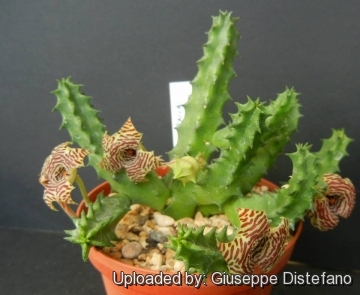 Huernia loeseneriana Photo by: Giuseppe Distefano
Huernia loeseneriana Photo by: Giuseppe Distefano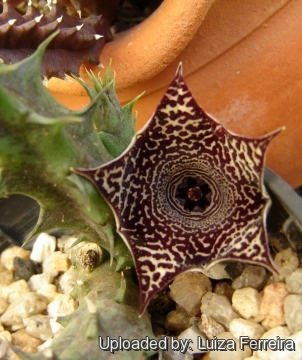 Huernia loeseneriana Photo by: Luiza Ferreira
Huernia loeseneriana Photo by: Luiza Ferreira Huernia loeseneriana Photo by: Giuseppe Distefano
Huernia loeseneriana Photo by: Giuseppe Distefano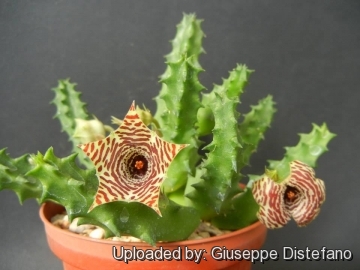 Huernia loeseneriana Photo by: Giuseppe Distefano
Huernia loeseneriana Photo by: Giuseppe Distefano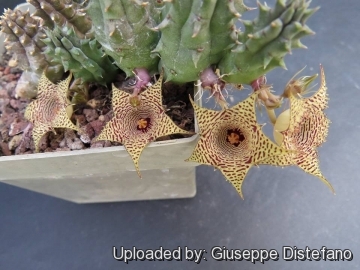 Huernia loeseneriana Photo by: Giuseppe Distefano
Huernia loeseneriana Photo by: Giuseppe Distefano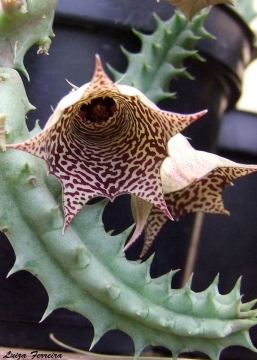 Huernia loeseneriana Photo by: Luiza Ferreira
Huernia loeseneriana Photo by: Luiza Ferreira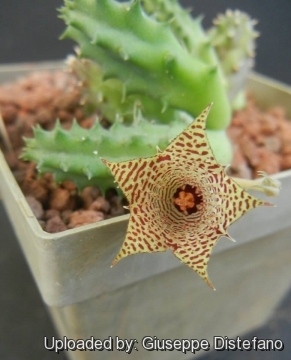 Huernia loeseneriana Photo by: Giuseppe Distefano
Huernia loeseneriana Photo by: Giuseppe DistefanoSend a photo of this plant.The gallery now contains thousands of pictures, however it is possible to do even more. We are, of course, seeking photos of species not yet shown in the gallery but not only that, we are also looking for better pictures than those already present.
Read More... Cultivation and Propagation: Huernia loesenerianaSN|26308]]SN|26308]] isn't difficult to grow and flower.
Spring: When winter ends and they begin to grow again, they will require much water and soaking the pots will no longer put the plants at risk for rot. In the spring they will grow well in partial shade and leaving them out in the rain may provide them with the water they need.
Summer: In the summer months they will tolerate heavy rain, but will be just as happy if the season is dry. It's best to sort out the stems while the plants are resting in the summer before they begin their autumnal growth cycle. They will tolerate very hot weather outdoors as long as they are kept in filtered light and this will encourage them to flower in the Autumn. They also enjoy some fertiliser. Moving the plants as they are developing buds may cause them to spontaneously abort the flowers all together.
Autumn: In the fall keep them outdoors until the night time temperatures drop below the 5°C.
Winter: Winter care presents no problems at 5°-10° C with plenty of light. As soon as they are flowered be sure to take extra precautions to keep them dry, because damp cool conditions when the plants are resting is an invitation to fungal infections, but - according to temperatures –some occasional lit watering may be useful.
Potting medium: Since roots are quite shallow, use a cactus mix or add extra perlite or pumice to regular soil potting soil. A gritty, very free-draining compost is suitable, and clay pots help the plants to dry out between watering. Re-pot every 2 years.
Pest and diseases: Huernia are generally fairly easy to grow, especially if kept pest-free. They are very susceptible to stem and root mealy bugs, and damage from these may well initiate fungal attack. Any time when there is a dead or dying stem in the pot it is important to remove it immediately and completely before other healthy stems can become ill too, isolate the healthy parts, dry them off, and re-root them in new compost.
Propagation: Easiest with stem cuttings. Allow cuttings to dry a day before planting. Stems must be laid (Not buried) on gritty compost and will then root from the underside of the stems. It can also be increased from seeds sowing in spring in moist, sandy peat moss. Barely cover seeds. Seeds germinate quickly.
In any season it's best to lay the stems out for several days before replanting them and then pot them only in dry soil and withhold any water until they begin to shrivel or start growing again.


















